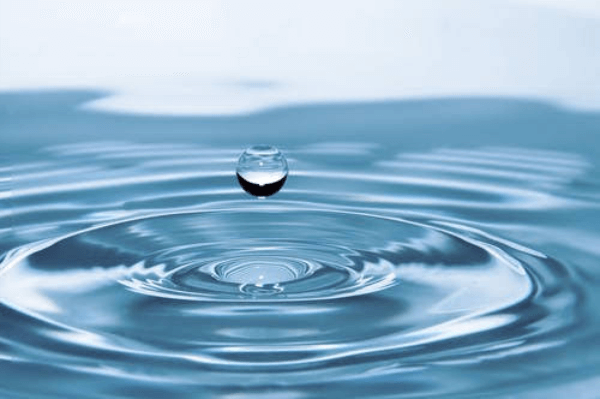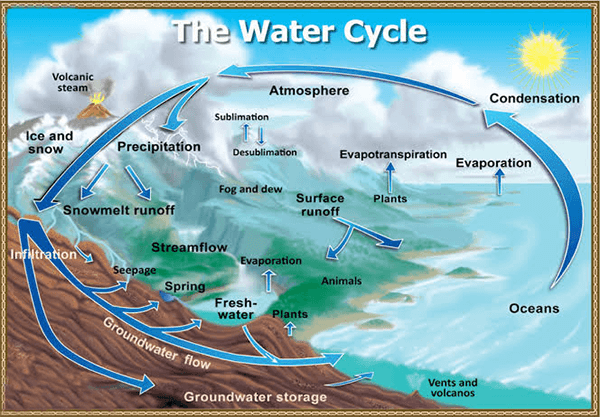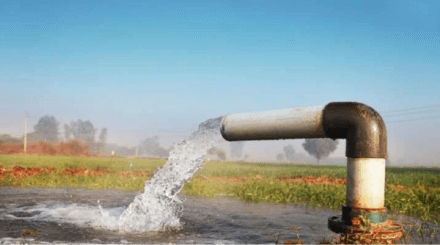Essay on Water
Water is a renewable resource essential to every life form on the planet. The human body and aquatic living creatures are primarily made up of H2O (chemical formula of water). Water is necessary for good health, humidity control, air transmission in the bloodstream, and joint maintenance. Water is among the most precious natural resources. According to a National Geographic survey, about 1 billion people worldwide do not have a constant clean water supply, and more than 2.6 billion do not have sanitary facilities. Water FormationWhen we talk about water formation, we must understand water's natural process or cycle. A water cycle refers to a process in which water evaporates from the ocean, lake, ponds, river and many other water bodies and goes into the air as a vapour to the clouds. The sun plays a vital role during the vaporization process in the atmosphere. Later, all these droplets get up to make the cloud called condensation, and after becoming the cloud, it rains back to the earth and forms the river, pond, lake, sea, or ocean. This process is continuous and natural. 
Origin of WaterThe origin of water on earth is the focus of extensive research in astrophysics, earth science, and planetary science. Earth is the only planet found to produce seas of drinkable water in the environment among some of the hilly planets in the Solar System. This was primarily assumed that the water on the planet didn't even come first from earth's natural portion of the planetary system. Water and other vapours were thought to be brought to earth from the rest of the solar system soon in its existence. The Evolution of Water on EarthOne aspect in determining whenever water first formed on Land is that water is continuously flown to space. Water would've been passed to the universe whenever the earth was earlier and far less large. Lighter elements like hydrogen and helium are predicted to drain continuously from the atmosphere. The present atmosphere shows that even heavier elements in the early environment experienced significant losses. During the final stages of its formation, all water on earth would be disturbed by the Lunar surface collision roughly 4.5 billion years ago, which evaporated most of the planet's crust and upper mantle and generated a rock-vapour atmosphere surrounding the new-born planet. Major Research on WaterAccording to a National Geographic survey, 1 billion people worldwide do not have a constant clean water supply, and more than 2.6 billion do not have sanitary facilities. This implies that every year, approximately 3 billion humans may be exposed to water-related disorders, such as the growth of viral hepatitis and diarrhoea. Most individuals in underdeveloped nations have access to less than 25 litres of safe drinking water daily, whereas those in rich countries consume over 150 litres daily. Water is a valuable resource that people have spent thousands of years attempting to manage. Several historical examples show how water has greatly influenced people's lives. Water ResourcesWater supplies are natural sources that may be valuable to humans in many ways, such as drinking water or irrigation water. Only 3% of the water on the planet is fresh water, and little more than two-thirds of that is frozen in glaciers and polar ice caps. There are several stories concerning environmental disasters and flooding in Egyptian Civilization. The Nile River appeared holy to early Egyptians and therefore was called a Life-Giver primarily since it supplied water needs, including all farming, cultivation, and living. While our government internationally handles several varied natural supplies with variable levels of accuracy, there are also no worldwide regulating institutions to put water concerns together at the international level. Water is a vital natural resource, and the demand for global water administration is becoming increasingly crucial. This is owing to several local or regional examples of misuse, pollution, and a shortage of access to clean drinking water. Many international firms have failed to reach a solid agreement on how to regularly tackle such challenges on a global scale. Life-changing ImpactsWater contains several different biochemical qualities essential for life's expansion. It does this by allowing organic chemicals to react in ways that eventually allow reproduction. Water is required for the photosynthesis process. Photosynthesizing organisms use the sun's energy to separate hydrogen from oxygen in the water. Hydrogen reacts with Carbon dioxide to produce glucose and the central part of oxygen. Aquatic organismsLife on the surface is abundant in earth's oceans, and it is believed that the first living forms arose in water. Despite this, fish and many marine animals, such as dolphins and whales, live in water. There is also a presence of oxygen in water molecules, and most fishes breathe underwater through this. For living, sea creatures must get oxygen in a variety of ways. Fish have gills rather than lungs; however, some species, such as the Lungfish, have both. Sea creatures such as dolphins, sharks, sea lions and seals regularly come to the water's surface to breathe air. For living, sea creatures need pollution-free water. Drinking WaterHuman beings need drinking water to live, and it is necessary to use pure water. Drinking water is water that is used for direct consumption or with food items. Clean or pure water is potable water. The amount of water needed to sustain better health increases according to physical activity level, age, health-related disorders, and environmental circumstances. Drinking dirty water can cause many diseases in humans. Water SupplyTubes are the most effective and convenient means to carry and supply drinkable water. However, some systems have exorbitant operational expenses, such as plumbing might need a significant financial expenditure. The cost of replacing nations' industrialized things, which are failing hygiene and sewerage systems, might be around $200 billion annually. Modified and unmodified water damage from pipelines restricts water availability in society. Uses of WaterThe overall amount of water available anywhere at one moment is an essential aspect to consider. Many human water consumers have occasional water needs, and some crucial uses or needs for water include the followings: 
IrrigationIt is believed that 70% of available water is utilized for irrigation, while 15-35% of irrigated agriculture withdrawals are unsustainable. It takes around 2,000 - 3,000 gallons of water to generate enough food to meet one person's daily nutritional requirements. To generate food for the planet's current population of almost seven billion people, a waterway ten meters deep, 100 meters wide, and 2100 kilometres long would be required. Aquaculture is a relatively new but rapidly expanding agricultural use of water. Freshwater fisheries and aquaculture are also agricultural uses of water but have been given a lesser priority than irrigated. Industrial UsesWater is a necessary part of the production of transistors and circuits found in laptops, cellular phones, and vehicles. All through the process, ultrapure water is utilized to eliminate contaminants from silicon chips. Water is used in the production of renewable energy. The force of fluid falling downhill drives a turbine attached to a generator, generating electricity. Water is also employed in numerous large-scale industrial operations, including thermoelectric power generation, oil refining, fertilizer manufacture, chemical plant applications, and natural gas extraction from shale rock. Raw water discarded after industrial applications become pollutants that can harm the environment. Household UsesResidential water usage accounts for approximately 8% of the world's water. Examples include bottled water, bathing, preparing food, wastewater reuse, cleaning, washing, and gardening. In 2017, more than 840 million people were without access to even basic drinkable water. About one hundred fifty-nine million of these individuals consume water directly from surface water sources such as lakes and streams. EnvironmentSpecified environmental water usage accounts for a modest but rising proportion of total water consumption. Watering natural or artificial wetlands, creating lakes meant to enhance animal habitat, fish ladders, and water releases from reservoirs to help fish spawn or restore more natural flow regimes are all examples of environmental water usage. Other UsesWater has a high vaporization temperature and is generally neutral, making it an effective fire extinguisher fluid. However, we must avoid using water to prevent fire in some cases. When using water in fire prevention, we must be cautious and proactive, considering the risks of a small explosion, which can occur when water is used in tight spaces, especially over hot flames. Types of Water & Purposes1. Tap WaterTap water comes directly from the water tanks established by the government associations. This type of water is commonly used for home cleaning, baking, planting, and laundry. It may or may not be suitable for human consumption, and this must respect the rules and regulations established by the local municipal entities. 2. Mineral WaterMineral water refers to pure water that includes minerals and gases dissolved organically. It is derived from groundwater sources, making it high in minerals such as calcium, magnesium, and manganese. Because of the needed minerals, it has the character of being safe water to drink. Mineral water composition varies from area to area; some may contain more minerals than others. 3. Spring WaterRainwater collected underground tends to come out as a spring or pool near the surface. Organic springs are not treated by a municipal water system but are still deemed safe to drink because they originate underground. 4. Well WaterA well is a hole dug through into earth to obtain water from underground. Wells come in various sizes based on the type of rock dug into them and the amount of water pulled out. Deep wells immediately extract groundwater and transport this to the level where citizens can drink it. 5. Purified WaterThe purified water has been cleaned in a process since being extracted out of its origin. Purification eliminates germs, pollutants, and dissolved solids, making the water safe for drinking and other uses. There are several approaches used to purify water. 6. Distilled WaterDistilled water, also known as de-ionized water, is water that has been treated using osmosis and distilling to remove all minerals and salt. 7. Sparkling WaterSparkling water refers to water that has been carbonated to turn a liquid bubbly like soda. Sparkling water can be spring water, refined water, or fizzy water treated with atmospheric co2. Water that is not suited for drinking but may not be dangerous to people if used for swimming or showering is known by numerous names besides hygienic or fresh water and is frequently referred to as safe water. Freshwater is a sustainable resource that is allowed to flow through the natural water cycle. However, its accessibility is under stress due to its inherently uneven distribution in time and space, increasing economic demands from agriculture and industries, and increasing pollution. Facts About Water
Taste and OdourWhile humans have specialized receptors indicating the existence of water in their mouths, and frogs are believed to be able to detect it by smelling it, clean water is generally considered tasteless and odourless. ConclusionFreshwater is a precious and restricted natural resource; most of it is becoming infected by bacterial infections and toxic compounds. The human need for fresh water is growing. Also, water is necessary to cultivate crops to maintain the world's fast-growing population.
Next TopicEssay on My Family
|
 For Videos Join Our Youtube Channel: Join Now
For Videos Join Our Youtube Channel: Join Now
Feedback
- Send your Feedback to [email protected]
Help Others, Please Share










